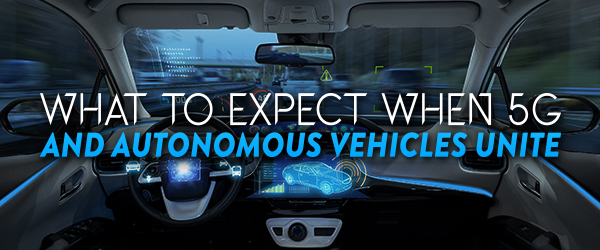
What to Expect When 5G and Autonomous Vehicles Unite
Since the 1990’s, customers who use cell phones and other wireless technology have done so using a “G” network. This network began with the 2G utility that mainly covered only text messages. With each updated network came more capabilities. The 3G wireless network added internet access in 1998. In 2008, the upgrade to 4G made sharing videos much easier. Now, the next innovation in wireless networking is here – the 5G network is expected to go live in 2020 or shortly thereafter, adding smart home and HD video sharing capabilities. With 5G networks, smart cities, robots, virtual reality, and even self-driving cars will be more than just concepts —they will be reality.
5G Technology Explained
Like all upgrades before it, the 5G network will give smartphone and tablet users a faster connection to the internet. Experts anticipate that 5G speeds will be about ten times faster than the current 4G network, allowing users to download HD and even 3D videos in less than a minute. This upgrade will also make the network more stable and allow for more devices to connect to it at the same time.
With the ability to host more devices, the Internet of Things is going to expand. Robots, sensors, homes, and smart cars will all be able to have stable 5G connections at all times with virtually no lag, allowing for uninterrupted communications with hubs and other servers. 5G will do this through super-high-frequency airwaves. These higher frequencies allow for more bandwidth and faster speeds. Like many airwaves, however, they do become weaker the farther from transmitters that they travel. Walls and other physical objects can also impede them.
The solution to these problems is small cells. By placing thousands or millions of these small transmitters throughout a city, the entire area becomes incredibly well-connected to the 5G network. This does mean that 4G will still be needed in rural areas, but for urban settings, 5G will allow for autonomous vehicles to become more than merely theoretical concepts or prototypes. They will become the norm, and unlike some test vehicles, they will also be very safe. This 5G stable connection ensures that self-driving cars can instantaneously communicate with a central traffic control system and with each other, eliminating many risks encountered by current test vehicles.
The Construction of the 5G Network
Like its predecessors, the 5G network is being constructed by cell phone carriers. These carriers and processor chipmakers who are working on the devices that will broadcast the network will be the first to benefit from it. However, they will have to bear the burden of funding the equipment and research needed to roll out this network.
That cost is estimated to be as much as $300 billion. While that would provide 5G service across the country, it’s still a very large amount of money that carriers and equipment manufacturers would have to expend. That’s where the U.S. government comes in. While there’s no final approval yet, President Trump’s administration has considered a publicly-funded 5G network. This network would be considered a public utility. However, whether or not this utility will be funded is still uncertain.
Expected Launch Window
While there are some small 5G test networks currently in place, widespread deployment is not expected until 2020. The technology has been approved by 3GPP, a consortium of international wireless experts. The United Nations is expected to review the 3GPP recommended standards for 5G next year. Following that, compatible devices can be sold to consumers.
One of the reasons the launch window is several years away also has to do with cost. Carriers are hopeful that innovations in 5G devices will help decrease the $300 billion in expected costs.
The Smart Vault and 5G Deployment
The SYNDÉO Smart Vault is expected to play a major role in 5G deployment. As the medium for 5G technology, the Smart Vault offers a number of benefits. The vault is a small equipment housing unit that can be embedded in a sidewalk, curb, or terrace anywhere in a city. It blends in with other embedded housing and features as a slip-resistant panel that is safe to walk on. The Smart Vault comes in a number of sizes and configurations, so it can be integrated within a wide range of areas.
With the cost of 5G equipment, protecting this investment is clearly necessary. The waterproof and environmentally controlled Smart Vault protects expensive equipment from the weather and from theft, ensuring that the network has no outages. This will be absolutely vital for autonomous vehicles. Any time a self-driving vehicle loses connection could result in an accident. By ensuring that 5G equipment is near the street and protected, the Smart Vault helps eliminate this concern. The Smart Vault will ensure that the 5G equipment operates as designed, allowing smart cars and other devices to have a stable, fast connection to the network at all times.

